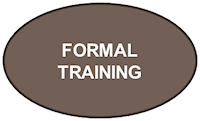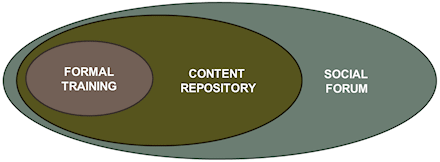This post is the third in a series in which I deliberate over the semantics of education.
I dedicate this one to Jane Hart whom I was delighted to meet in-person in Sydney last month. Jane is a renowned advocate of performance support in the workplace, and I wonder what she’ll make of my latest musing.
While much of Jane’s work exposes the difference between training and performance support – and implores us to do less of the former in favour of the latter – my post here does not. The difference between training and performance support proxies (at least IMHO) the difference between formal and informal learning, and I do not intend to rehash that which others such as Jane have already documented so well.
Instead, I intend to explore the relationship between learning and performance support, with the former considered in its informal context.
I hasten to add that while much of Jane’s treatment of informal learning is in terms of social media, for the purposes of my post I will remain within the scope of broadcast content that is published by or on behalf of SMEs for consumption by the masses. The platform I have in mind is the corporate intranet.

A healthy corporate intranet comprises thoughtfully structured information and resources to facilitate learning by the organisation’s employees. While this content is typically delivered in an instructivist manner by the SME, it is probably consumed in a constructivist manner by the end user.
Much of the content – if not most of it – is designed to be consumed before it needs to be applied on the job. Hence I refer to it as “pre-learning”. It is undertaken just in case it will be needed later on, and is thus vulnerable to becoming “scrap learning”.
But of course not all pre-learning is a waste of time; some of it will indeed be applied later on. However it may be quite a while before this happens, so it’s important that the learner can refer back to the content to refresh his or her memory of it as the need arises. This might be called “re-learning” and it’s done just in time.
To support the learner in applying their learning on the job, tools such as checklists and templates may be provided to them for their immediate use. These tools are called “job aids” and they’re used in the workflow.
However job aids aren’t the only form of performance support. Content in the ilk of pre-learning may be similarly looked up just in time, though it was never learned in the first place. These concepts may be so straight-forward that they need not be processed ahead of time.

To illustrate, consider the topic of difficult feedback.
James is a proactive manager who reads up about this topic on the corporate intranet, watches some scenarios, and perhaps even tries his hand at some simulations. But it’s not until an incident occurs a couple of months later that he needs to have that special conversation with a problematic team member. So he refers back to the intranet to brush up on the topic before going into the meeting armed with the knowledge and skills he needs for success.
Jennifer also explores this topic on the intranet while she’s in between projects. Some time later she finds that she too needs to have a conversation with one of her team members, but she feels she doesn’t need to re-learn anything. Instead, she’s comfortable to follow the step-by-step guide on her iPad during the meeting, which gives her sufficient scaffolding to ensure the conversation is effective.
George, on the other hand, has been so busy that he hasn’t gotten around to exploring this topic on the intranet. However he too finds that he must provide difficult feedback to one of his team members. So he quickly looks it up now, draws out the key points, and engages the conversation armed with that knowledge.
The point of these scenarios is not to say that someone was right and someone was wrong, but rather to highlight that everyone is subjected to different circumstances. Sure, one of the conversations will probably be more effective than the others, but the point is that each of the managers is able to perform the task better than they otherwise would have.

So when we return to the relationship between learning and performance support, we see a subtle but important difference.
Learning is about preparing for performance. This preparation may be done well ahead of time or just in time.
Performance support is about, umm… supporting performance. This support may be provided in the moment or – again – just in time.
Hence we see an intersection.
But the ultimate question is: so what? Well, I think an awareness of this relationship informs our approach as L&D professionals. And our approach depends on our driver.
If our driver is to improve capability, then we need to facilitate learning. If our driver is to improve execution, then we need to facilitate performance support.
Arguably these are two different ways of looking at the same thing, and as the intersection in the venn diagram shows, at least in that sense they are the same thing. So here we can kill two birds with one stone.




